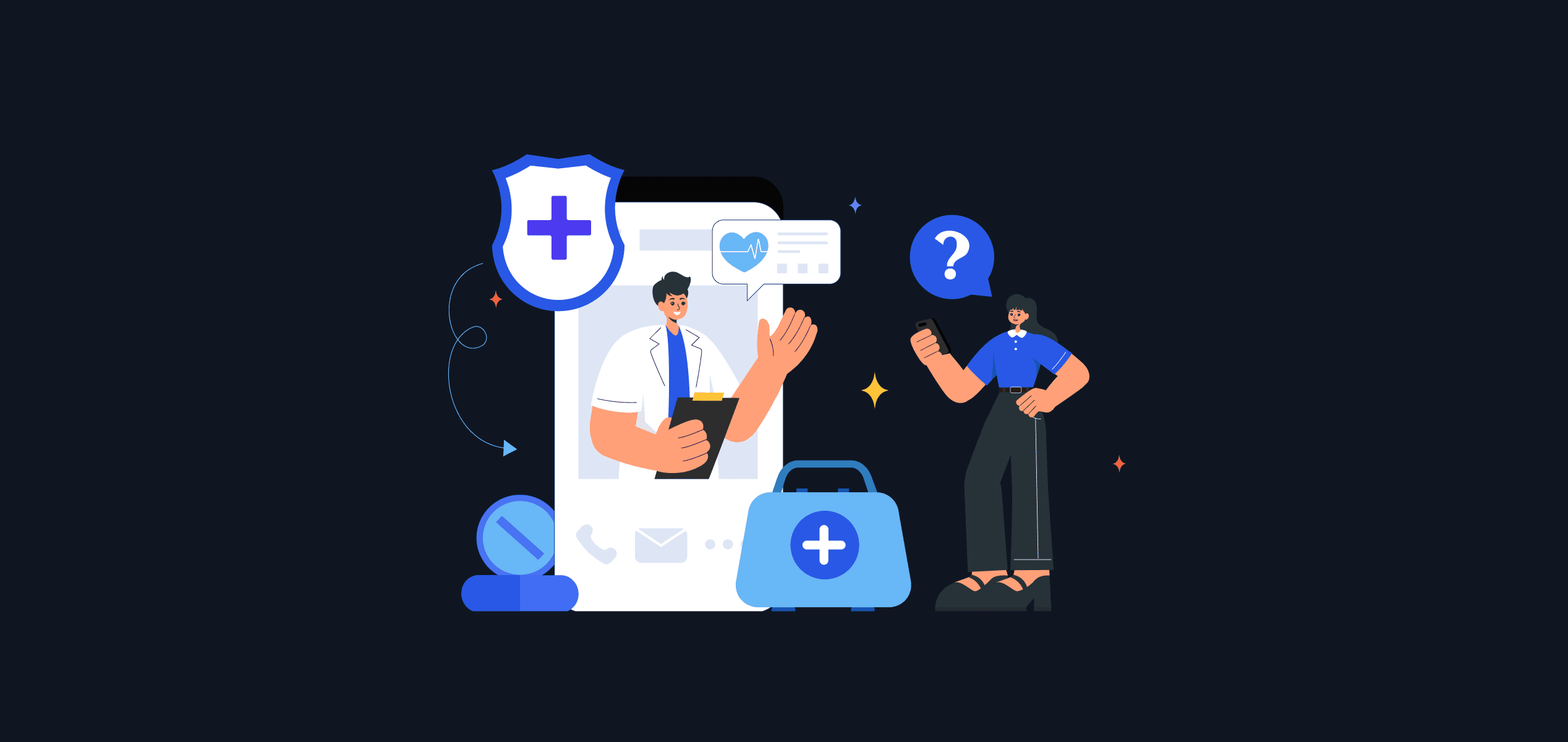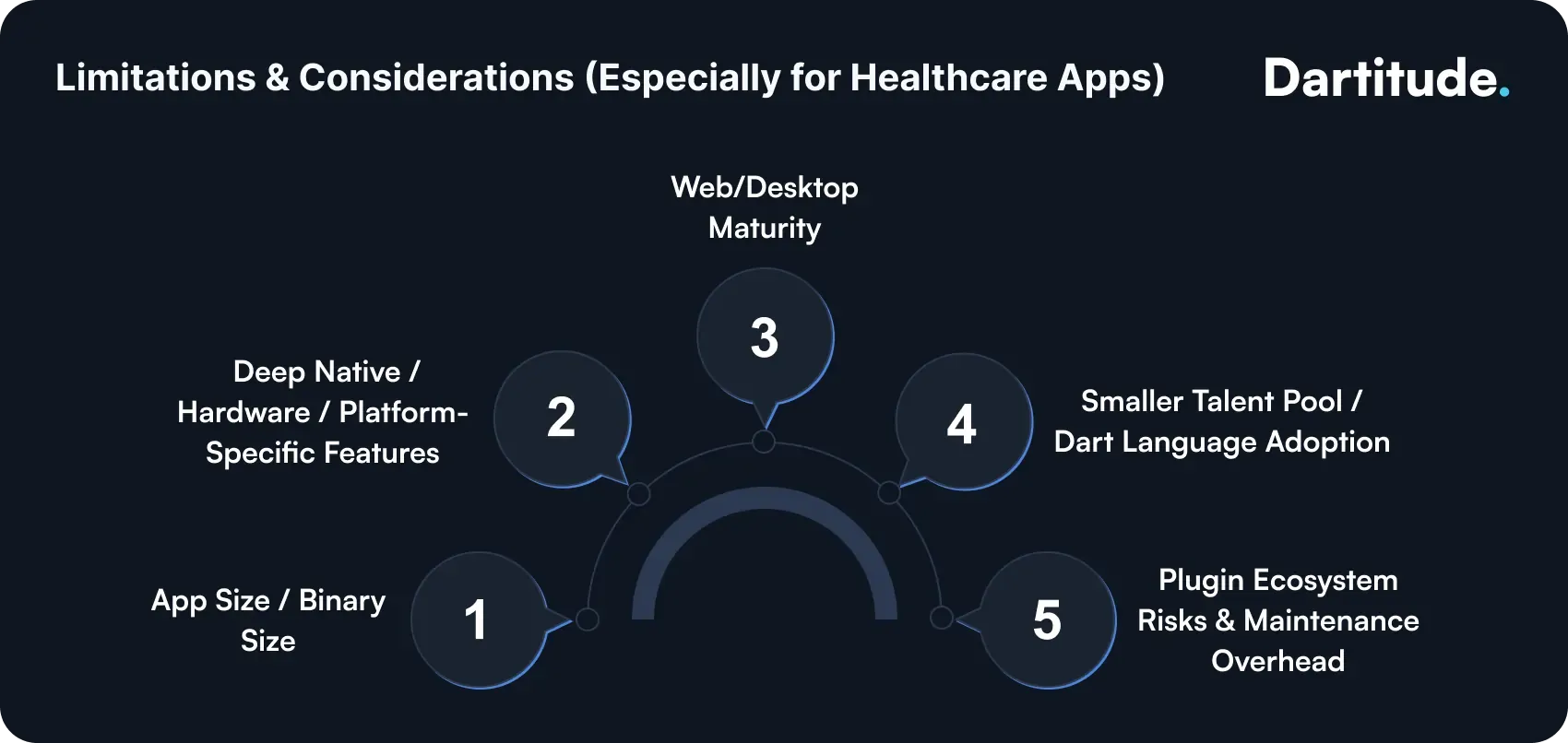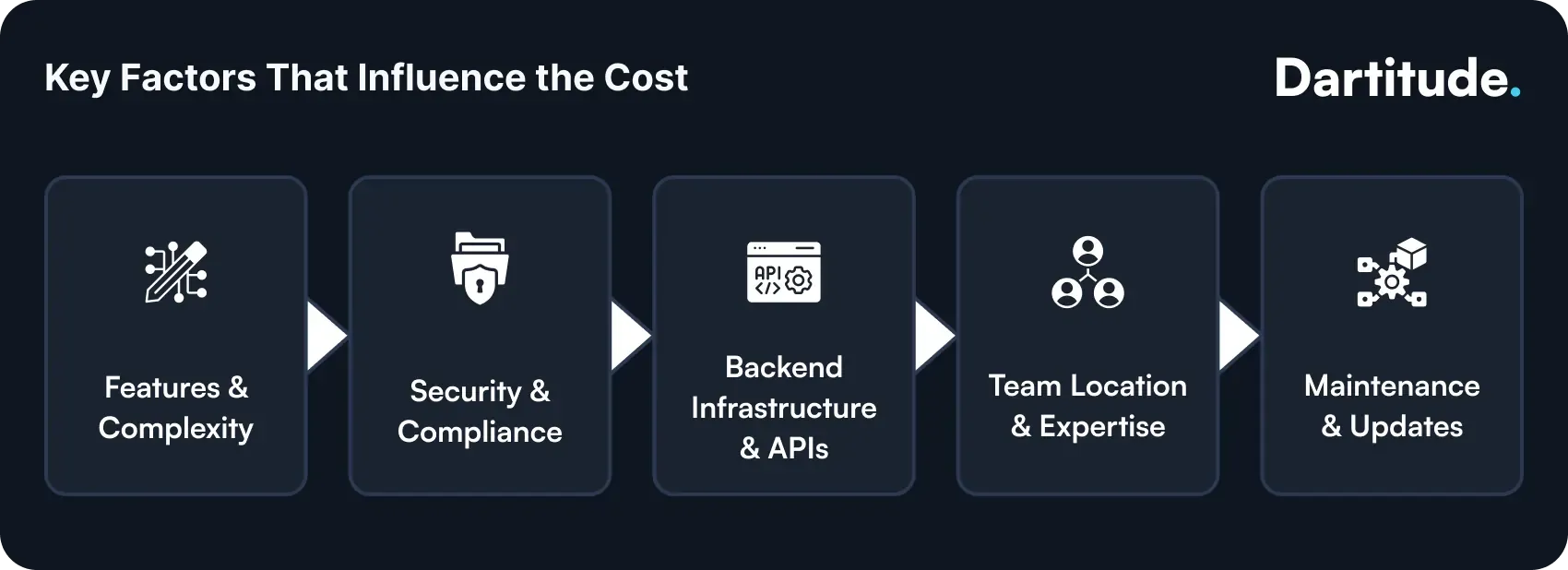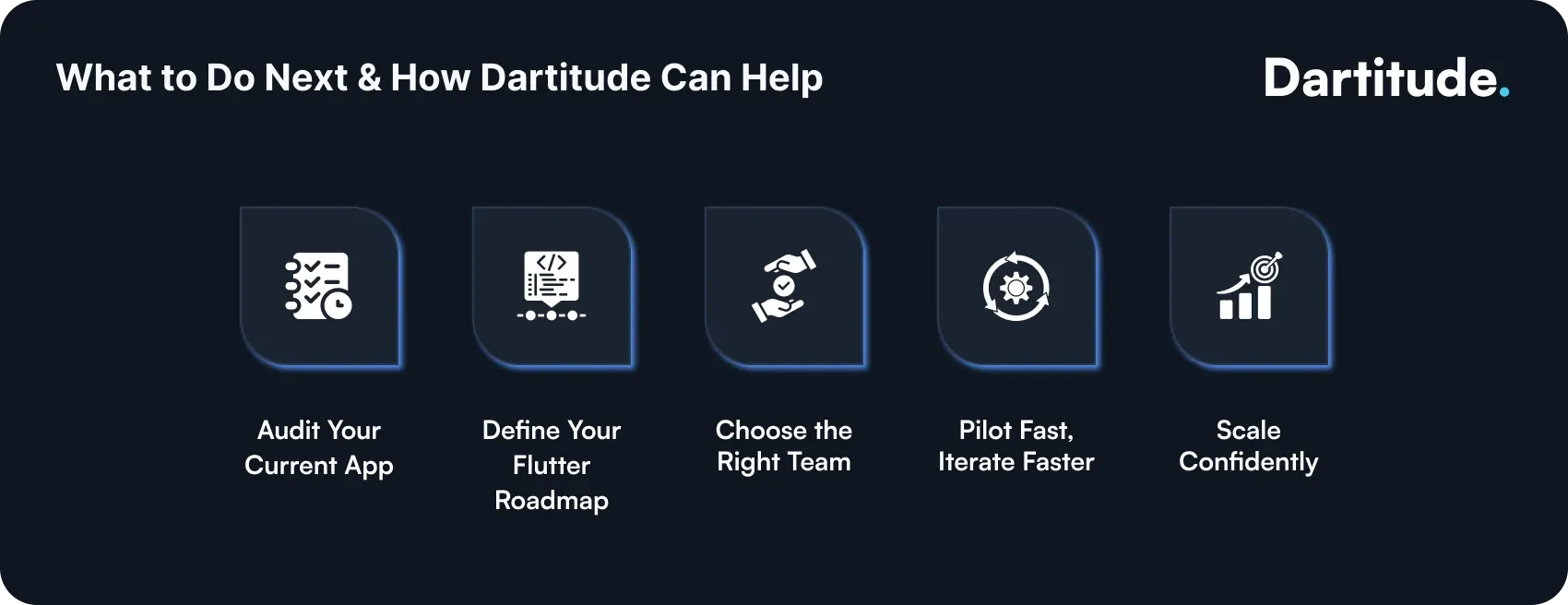
Flutter Healthcare App Development: Empowering Next-Gen Medical Solutions
The client called and said I need your help in saving my healthcare app. It is at the final stage of its life cycle. But why is it?
Further, patients were furious. Investors were walking away. Then our CTO said three words that transformed all at once: Let's use Flutter.
That was a year ago. Today, the same startup can manage 65,000 patient consultations per month.
Their Flutter healthcare app runs smoothly across different platforms such as iOS, Android, and the web. And they just closed a Series A round for finding too.
The main question still revolves around it: why are healthcare innovators worldwide making the same radical switch? Let's deep dive:
The Healthcare App Crisis Nobody Talks About
With the evolution of AI and ML in apps and websites across different industries, it has now become important to get your MVP integrated with AI-enabled features.
In the healthcare field, many of the apps are lagging due to the use of old technology and heavy data, changes in users' needs and preferences in the healthcare industry. The healthcare app market is very slow, and no one talks about why it is so.
It is not because of bad ideas, insufficient funding, but because of a brutal reality:
Traditional healthcare app development doesn’t have the capability to keep pace with fast-moving healthcare innovation.
During the journey, you are building up separate iOS and Android apps, integrating with hospital systems, fixing the inevitable bugs, ensuring HIPAA compliance, and your competitors have already launched. Your budget is getting beyond the estimated line. Your team is frustrated.
That's where the Flutter healthcare app development services take place, the framework that changes all the rules completely.
Why Next-Gen Medical Solutions Demand Flutter
As the technology is changing at a massive pace, healthcare systems have to provide real-time data-driven solutions to the users and clients. Older products that once took a year to launch are now outdated, pushing organizations to adopt cross-platform application development for faster and more efficient delivery.
With the use of Flutter’s single codebase, it easily allows multi-platform deployment, OS, Android, and web, without doubling your cost of development cost.
Now, things have changed in 2025. An app that usually takes 8–10 months with native development can no longer be finished within a cycle of 12–16 weeks. And that too is possible without compromising quality. It’s a high-performance, secure healthcare solution that feels native across multiplatform.
Emerging Trends in Flutter Healthcare App Development for 2025

The healthcare industry is moving fast, with no doubt, and here are the five important trends that are necessary for healthcare apps built with Flutter:
1. AI/ML Integration (Predictive Health, Smart Diagnostics)
The embedding of AI/ML and integration of advanced features have become crucial for healthcare apps built with Flutter. For example, symptom checkers, chatbots for triage, and analyzing patient risk through predictive analytics. It has been seen that strong use of AI is transforming the working process of healthcare professionals, too.
2. IoT, Wearables & Remote Patient Monitoring (RPM)
With the advancement of AI and everything getting connected with smart devices (wearables, sensors, connected devices) in healthcare, this has become an important trend. Due to the cross-platform nature of Flutter, it allows an app to act as a patient mobile, tablet for clinics, web dashboard, and a lot more.
3. Security & Compliance as First-Class Concerns
With the growth of digitalization across the globe, especially where data is an important part. Protection of data is not optional, but it's necessary in 2025. Due to the risk of data theft, risk to privacy, using Flutter allows you to create HIPAA-compliant Flutter apps that protect patient data without degrading the level of speed.
4. Adaptive & Inclusive UI / Accessibility
In healthcare apps, the need for the adaptive UI (accessibility support, dynamic themes) is important, and which are only possible due to Flutter’s capability. Further, the ability to quickly adapt and adjust according to UI for different users' preferences (disabled users, elderly patients have become critical.
5. Web & Desktop Convergence / Multi-Platform Experience
Yes, now, not everyone wants apps in healthcare, but they also have a demand for web portals, clinical dashboards, and desktop tools. When it comes to Flutter, its web/desktop app is capable enough that it can be used as a complete multi-platform health tech solution.
Advantages of Flutter for Healthcare App Development
If you are planning to build health tech apps, the presence of speed, security, speed matters the most. Several advantages of Flutter can be considered:
1. Single Codebase for Multiple Platforms
In Flutter, you just have to write one codebase and deploy to iOS, web, and Android. It constantly minimises the development time, maintenance, and testing effort. If it is a startup, it is more beneficial as it has faster market entry, constant UI across different devices of doctors/ patients, and identification of bugs.
2. FHIR & Cloud Healthcare API Support
As Flutter is highly compatible with FHIR-compliant data models and the Google Cloud Healthcare API, it is great for applications that need teleconsultation workflows, hospital systems, and medical records.
3. Near-Native Performance & Rich UI
Flutter with recent upgrades, such as the Impeller engine, provides you with smooth animations, responsive UI, and extraordinary performance. For medical applications (such as telemedicine video and patient-monitoring dashboards), performance is essential; hence, Flutter's capabilities in this niche are important.
4. Cost Efficiency
Yes, Flutter is cost-effective as you do not need to require an additional set of team to code for different platforms such as iOS, Android, and Web. Moreover, due to this, it is easy to regulate the maintenance, and updates can be applied right away to all platforms.
5. Growing Ecosystem & Tool
Now, we can use Flutter with DevTools, delivering good performance, more plugin support, which means that healthcare apps don't have to make additional adjustments on a larger scale.
Limitations & Considerations (Especially for Healthcare Apps)

Since every technology has some weaknesses, one should be aware of certain limitations while using Flutter in healthcare settings.
1. App Size / Binary Size
The size of Flutter apps is relatively large in comparison to strict native apps due to the engines and frameworks involved in it. Onboarding patient apps may require less weight in healthcare deployments (e.g., rural areas, older devices, low-storage phones).
2. Deep Native / Hardware / Platform-Specific Features
Flutter does support numerous capabilities via its plugins, such a you might require to create native platform channels if your healthcare apps need additional hardware integration for example, advanced Bluetooth LE, AR/VR, medical device sensor, and more. This, however, enhances the medical apps' complexity, also increasing your cost.
3. Web/Desktop Maturity (for healthcare web portals)
As it grows quickly, Flutter for web development and desktop apps is still not always at the same maturity level as native web frameworks. For healthcare web dashboards with heavy data visualization, large tables, and real-time streaming, you may find edge cases. If your health-tech architecture expects high-end web platform performance, evaluate accordingly.
4. Smaller Talent Pool / Dart Language Adoption
Flutter is written in Dart. Compared to native/React, Dart/Flutter has fewer experienced developers in various markets, despite its growth. You might need to schedule staff onboarding and training for healthcare apps, which frequently require stringent QA, validation, and regulatory paperwork.
5. Plugin Ecosystem Risks & Maintenance Overhead
It is quite challenging to rely on third-party services that can be non-compliant, unsupported in an industry like Healthcare. It is possible that some older Flutter plugins do not fully meet legal or corporate standards. For example, accessibility may require additional manual effort by using Flutter, which is important in the healthcare field.
ProTip: If you’re planning to build a Flutter healthcare app, start with a clear architecture strategy that includes HIPAA compliance, data encryption, and FHIR integration from the starting day. This not only provides you with faster approvals but also minimizes technical errors as your platform grows.
Real-World Use Cases of Flutter in Healthcare
Here are a few ways Flutter is transforming digital health through cross-platform application development today:
1. Telemedicine Platforms
Flutter is beneficial for telemedicine platforms as it allows and offers a smooth video, chat, and patient record management across different devices.
2. Remote Patient Monitoring (RPM)
Heart rate sensors and glucose monitors may be readily connected to patient dashboards by developers thanks to Flutter's IoT and Bluetooth API support.
3. Medical Record Management
It has now become more easier way for doctors and patients to communicate records in real time with proper HIPAA-compliant interfaces.
4. Healthcare Dashboards & Analytics
By adopting Flutter, hospitals can easily enhance their decision-making and transparency of operations as it provides unified dashboards for nurses, physicians, and staff.
5. Fitness and Wellness Apps
Without hiring any separate teams, now it is convenient for startups to build fitness and AI-based symptom trackers with the help of Flutter.
From telemedicine to fitness tracking, Flutter for Healthcare Apps boosts innovation across every side of the health-tech atmosphere.
Flutter Healthcare App Development Cost in 2025
The cost to develop a Flutter healthcare application in 2025 can vary from $10000 to $50,000+, depending on platform integration, complexity, and regulatory requirements.
To optimize your budget portfolio and to get top-quality results, it’s important to hire Flutter developers who understand healthcare compliance, data security, and multi-platform deployment
Let me help to better understand the cost for Flutter healthcare app development:
Estimated Cost by App Complexity
As you can see, the cost of Flutter healthcare app development completely relies on the project’s complexity level and goal. Below is the estimated cost:
| App Type | Estimated Cost (USD) | Typical Features |
| Simple App | $10,000 – $25,000 | Basic UI, login/signup, appointment booking, reminders |
| Medium Complexity App | $30,000 and $80,000 | Patient records, chat, video calls, doctor dashboards |
| Complex App | $80,000 and $200,000+ | EHR integration, AI-driven insights, IoT/wearables, analytics dashboards |
As the cost is majorly affected by the software complexity, other factors like geographic location and developer rates matter too.
While price is largely influenced by the complexity of the software, developer rates, and geographic location also play an important role.
Location-wise cost comparison
Ultimately, the best location for your Flutter healthcare app development depends on your goals; whether you’re optimizing for cost, speed, or compliance.
| Country | Average Hourly Rate (USD) | Remarks |
| India | $20 to $50 | Ideal for startups & MVPs; best value for cost |
| United States | $80 to $150 | High-quality but expensive; suited for enterprise projects |
| United Kingdom | $50 to $150 | Balanced cost; great for regulated healthcare solutions |
| Germany | €65 to over €100 | Focus on precision, compliance, and high-security standards |
| Canada | $80 to over $200 | Strong compliance expertise (HIPAA/PIPEDA) and quality output |
Also Read: Hiring cost of Flutter Developers in 2025
Key Factors That Influence the Cost

There are many factors affecting the cost of creating a healthcare app with Flutter. Below, I will discuss the factors affecting the cost of the Flutter healthcare app:
1. Features & Complexity
Cost increases with the sophistication of capabilities such as wearable sync, IoT connectors, AI triage, and healthcare modules. Device testing, backend APIs, and cross-platform UI consistency are all required for each new module.
2. Security & Compliance
It is critically essential for Flutter healthcare apps to follow and comply with regulations such as HIPAA, PIPEDA, and GDPR. Your budget can be increased by more than $10,000 by implementing role-based access controls, secure APIs, and encryption.
3. Backend Infrastructure & APIs
Complex healthcare apps require a strong backend for records administration, billing, and insurance verification, but Flutter works great with the front end. This increases server and development expenses.
4. Team Location & Expertise
The cost of hiring developers can be reduced up to 60% from locations like Eastern Europe or India. Other locations, such as North America or Western Europe, are chosen for apps that need to comply with FDA or CE regulations.
5. Maintenance & Updates
Using Flutter allows you to minimize your performance monitoring, security audits, and regular updates. It is done by streamlining platform upgrades from a single codebase.
Pro tip: If you’re looking forward to developing or expanding your healthcare app in 2025, hiring a professional Flutter healthcare app development company ensures compliance-ready architecture, clear code, and scalability for the future, overall, without exceeding the budget.
What to Do Next & How Dartitude Can Help

Are you ready to transform your healthcare solution with Flutter Healthcare App Development?
Here’s how to move from idea to impact and how the right strategy (and partner) can make all the difference.
1. Audit Your Current App
The first step is to determine what is disrupting your health care platform. Do patients find iOS and Android incompatible? Does hospital system integration operate slowly or unreliably? A thorough Flutter app audit helps uncover hidden vulnerabilities from performance bottlenecks to data compliance challenges that Flutter can immediately solve, such as performance bugs and data compliance issues.
2. Define Your Flutter Roadmap
Without proper planning and research, it is difficult to develop an app or maintain the success rate for the long term. Once proper decision-making is done, focus on creating a roadmap showing cross-platform deployment, HIPAA/GDPR compliance, and extendable scalability.
3. Choose the Right Team
Knowing Flutter is only one aspect of developing a healthcare app; The second is understanding healthcare. You need a staff that can balance clinical compliance and coding accuracy. That’s where partnering with a trusted Flutter app development company can make the difference.
4. Pilot Fast, Iterate Faster
Start early. Flutter's hot reload feature makes real-time testing, modification, and deployment possible. Create a mobile, web, or tablet MVP and leverage input from patients or physicians to make quick improvements. What separates successful healthcare apps from those that never go beyond beta is the “build-measure-learn” cycle.
5. Scale Confidently
Scale wisely once your foundation is strong. Incorporate wearables, IoT, powerful data dashboards, and AI-powered diagnostics, without changing your software. Flutter's modular design guarantees seamless growth while maintaining performance and compliance as your user base grows and your use cases become more diverse.
If you're ready to scale, from updating apps to incorporating cutting-edge features, Dartitude Labs can help you design a system that facilitates your long-term expansion.
Final Thoughts: Building What Matters
With the evolution of AI and ML, the healthcare industry is changing with new technology and compliance standards. Flutter is shaping the overall healthcare app development- embedding speed, scalability, and security into a unified framework.
The requirements of patients are taking a shift towards data-driven analytics, seamless app performance with AI-enabled featureandd accessible care across platforms.
In 2025, success in app development isn’t about building faster apps; it’s about building smarter apps. Flutter allows healthcare innovators to launch secure, high-performance apps that expand effortlessly and adapt to future technologies like AI, IoT, and remote monitoring.
If your healthcare solution needs reliability, compliance, and growth without the technical overhead, Flutter is the right framework for you.
At Dartitude Labs, we don't build apps, but create innovative solutions.
Get in touch with our Flutter dedicated team to build your next-gen healthcare app, powered by Flutter, built for the future.
FAQs
1. How long does it take to build a Flutter healthcare app?
The timeline of developing a healthcare app relies on project complexity; for example, a basic MVP could take at least 3-4 months, while, app with advanced features, such as wearable integration, AI features, and EHR integration, might take almost 6-9+ months.
2. What’s the cost range for developing a Flutter healthcare app?
The cost for creating an app can start from $10,000 to $25,000, where mid-enterprise apps (AI modules, compliance, integrations) can reach $30,000 to $80,000. You must decide which type of apps you want to develop and accordingly maintain your budget portfolio.
3. How do I ensure HIPAA/GDPR compliance in a Flutter healthcare app?
You can ensure HIPAA/GDPR compliance by audit logging, end-to-end encryption, and secured storage, which are highly recommended. Selecting HIPAA- or GDPR cloud services and working with legal professionals is also crucial.
4. Is Flutter suitable for medical device/sensor integration (IoT, wearables)?
Yes, definitely. Flutter is good for medical devices as it supports native platform channels, allowing for enhanced integration with hardware and software. But if walking about specialised or certified medical devices, you need native modules, SDKs for validations with Flutter.
5. Do I need FDA approval or regulatory clearance for my healthcare app?
It completely depends on your app; if it is informational-based or tracking wellness, then you might not need FDA approval. But, if it is for treatment, diagnosis, or is a medical device, then FDS is needed for clearance.


